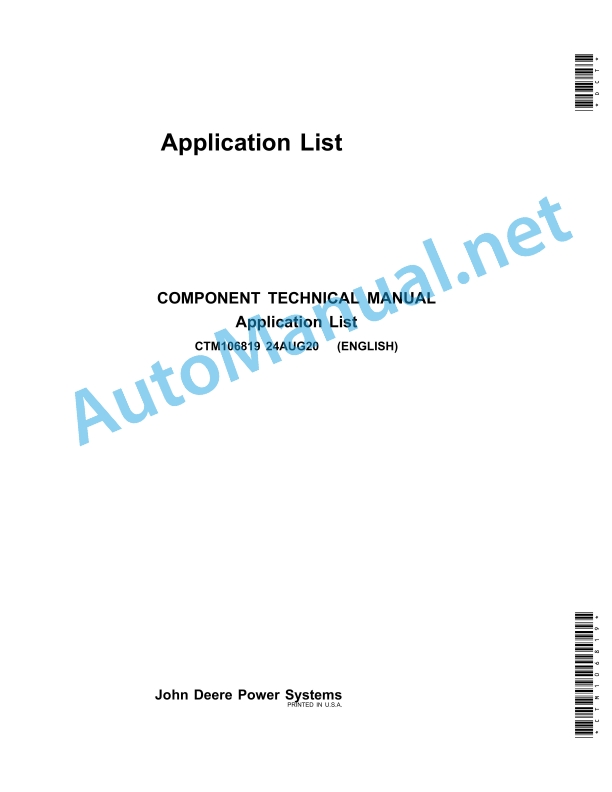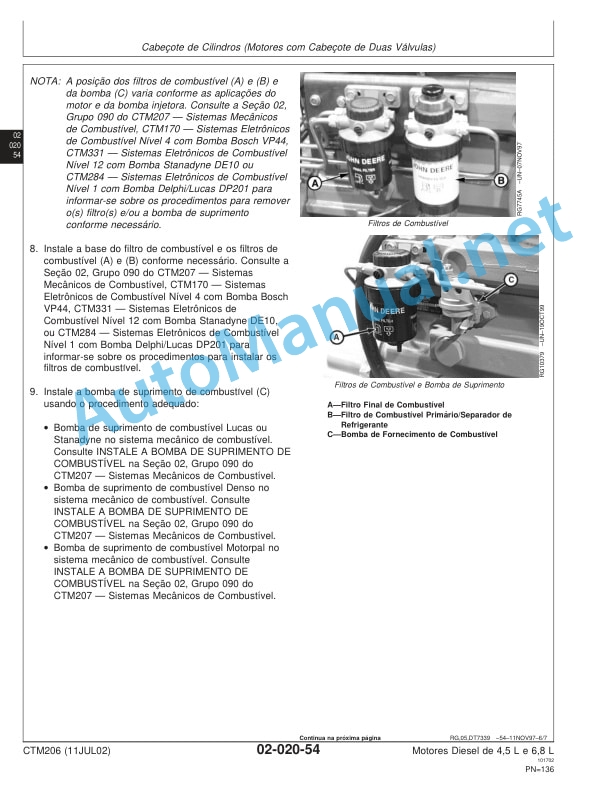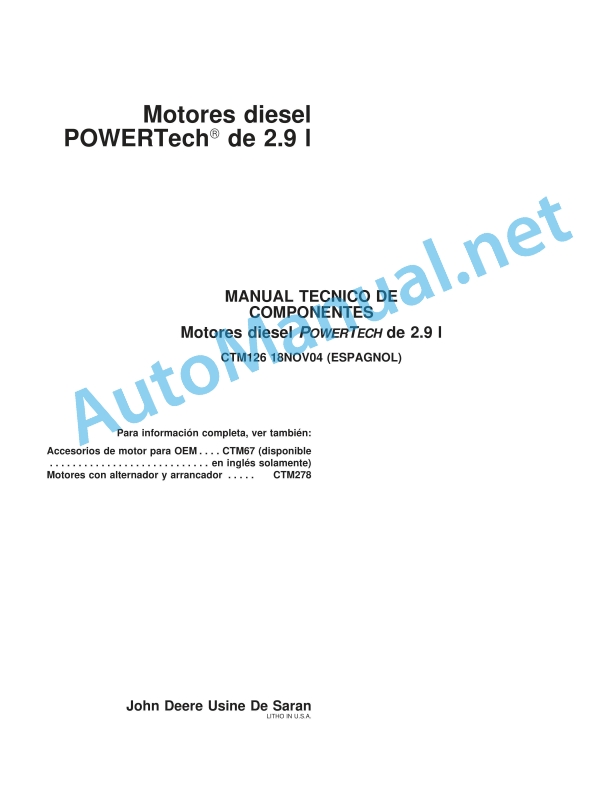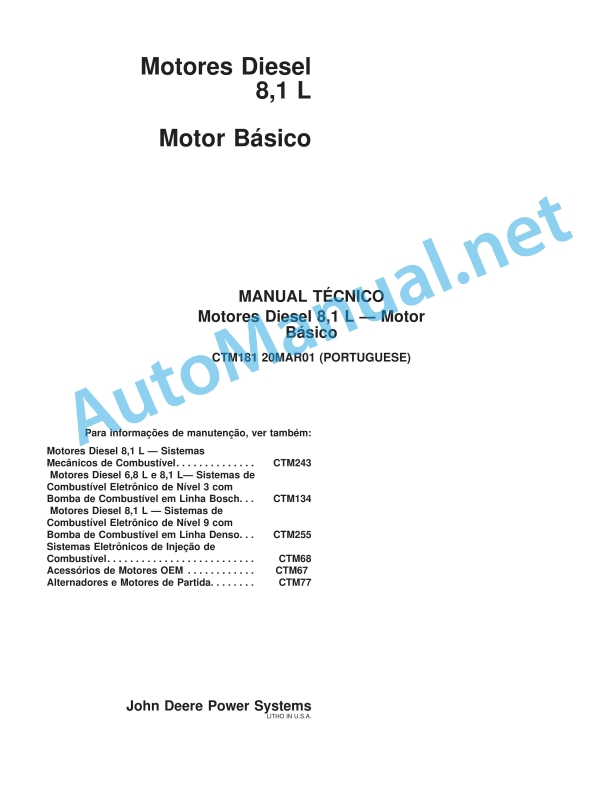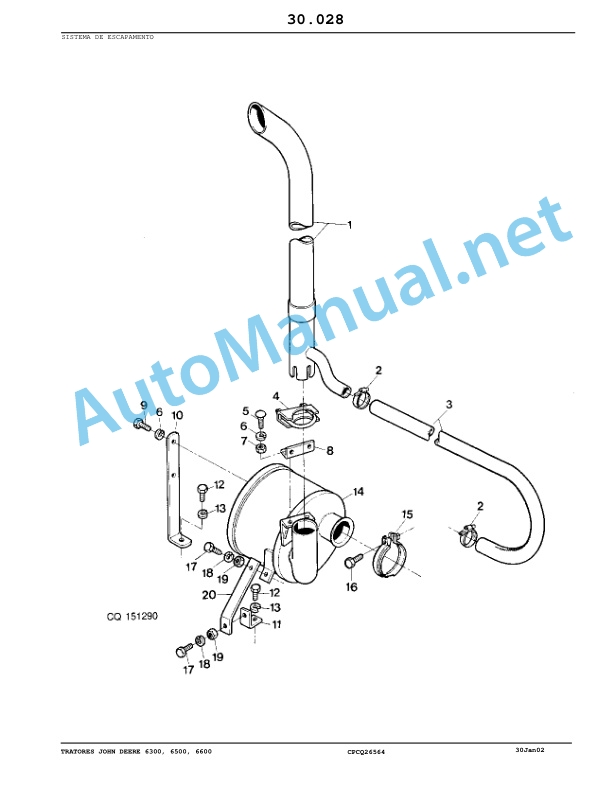Claas Torion 639 (K52) Wheel Loaders Operator Manual EN
$50.00
- Model: Torion 639 (K52) Wheel Loaders
- Type Of Manual: Operator Manual
- Language: EN
- Format: PDF(s)
- Size: 53.6 MB
File List:
00 0301 051 0.pdf
00 0302 360 2.pdf
00 0303 252 1.pdf
00 0301 051 0.pdf:
PROFI CAM 3
Table of contents
1 Introduction
1.1 Notes on the manual
1.1.1 Validity of manual
1.1.2 Information about this Operator’s Manual
1.1.3 Symbols and notes
1.1.4 Optional equipment
1.1.5 Qualified specialist workshop
1.1.6 Maintenance information
1.1.7 Warranty notes
1.1.8 Spare parts and technical questions
1.2 Intended use
1.2.1 Intended use
1.2.2 Reasonably foreseeable misuse
2 Safety
2.1 Identifying warnings
2.1.1 Hazard signs
2.1.2 Signal word
2.2 Safety rules
2.2.1 Meaning of Operator’s Manual
2.2.2 Observing safety decals and warnings
2.2.3 Optional equipment and spare parts
3 Product description
3.1 Overview and method of operation
3.1.1 How the PROFI CAM works
3.2 Identification plates and identification number
3.2.1 Position of identification plates
3.2.2 Explanation of PROFI CAM identification plate
3.3 Information on the product
3.3.1 CE marking
4 Operating and control elements
4.1 Camera system
4.1.1 Camera system monitor
4.2 Menu structure
4.2.1 Main menu
4.2.2
4.2.3
4.2.4
4.2.5
4.2.6
5 Technical specifications
5.1 PROFI CAM
5.1.1 Monitor
5.1.2 Camera
5.1.3 Switch box
5.1.4 Degree of protection against foreign bodies and water
6 Preparing the product
6.1 Shutting down and securing the machine
6.1.1 Switching off and securing the machine
6.2 Prior to operation
6.2.1 Carry out prior to operation
6.2.2 Installing the sun protection
6.2.3 Aligning the camera
6.2.4 Connecting the camera electrics
7 Operation
7.1 Monitor
7.1.1 Switching on the monitor
7.1.2 Calling up the menu
7.1.3 Setting a menu item
7.1.4 Setting the image orientation
7.1.5 Setting automatic screen darkening
7.1.6 Image mirroring
7.1.7 Setting the trigger view
7.1.8 Setting the follow-up time for trigger view
7.1.9 Setting the display mode
7.1.10 Activating/deactivating a display mode
8 Faults and remedies
8.1 Electrical and electronic system
8.1.1 Overview of problems on PROFI CAM camera system
8.1.2 Replacing the switch box fuse
9 Maintenance
9.1 Maintenance intervals
9.1.1 Every 10 operating hours or daily
9.2 Camera system
9.2.1 Checking the camera system for dirt
9.2.2 Cleaning the camera
9.2.3 Cleaning the switch box
9.2.4 Cleaning the monitor
10 Placing out of operation and disposal
10.1 General Information
10.1.1 Putting out of operation and disposal
11 Technical terms and abbreviations
11.1 Abbreviations
11.1.1 Units
11.1.2 Abbreviations
11.1.3 Technical terms
00 0302 360 2.pdf:
TORION 639TORION 535
Table of contents
1 Introduction
1.1 General information
1.1.1 Validity of manual
1.1.2 Information about this Operator’s Manual
1.1.3 Symbols and notes
1.1.4 Optional equipment
1.1.5 Qualified specialist workshop
1.1.6 Maintenance notes
1.1.7 Notes on warranty
1.1.8 Spare parts and technical questions
1.2 Intended use
1.2.1 Intended use
1.2.2 Reasonably foreseeable misuse
2 Safety
2.1 Identifying warnings
2.1.1 Hazard signs
2.1.2 Signal word
2.2 Safety rules
2.2.1 Importance of Operator’s Manual
2.2.2 Observing safety decals and warnings
2.2.3 Requirements for all persons working with the machine
2.2.4 Children in danger
2.2.5 Hazard areas
2.2.6 Persons riding on the machine
2.2.7 Hitching of machine to a trailer
2.2.8 Structural changes
2.2.9 Optional equipment and spare parts
2.2.10 Roll-over protective structure and falling object protective structure
2.2.11 Control of the machine while it is running
2.2.12 Operation only following proper putting into operation
2.2.13 Technical condition
2.2.14 Danger resulting from damage to the machine
2.2.15 Respecting technical limit values
2.2.16 Keeping the safety devices functional
2.2.17 Personal protective equipment
2.2.18 Wearing suitable clothing
2.2.19 Removing dirt and loose objects
2.2.20 Field of view and viewing aids
2.2.21 Preparing the machine for road travel
2.2.22 Hazards when driving on the road and on the field
2.2.23 Parking the machine safely
2.2.24 Unsuitable operating materials
2.2.25 Safe handling of operating materials and auxiliary materials
2.2.26 Fuel is harmful to your health
2.2.27 Refrigerant is harmful to your health
2.2.28 Environmental protection and disposal
2.2.29 Keep the cab free of chemicals
2.2.30 Fire hazard
2.2.31 Potentially fatal electric shock from electric overhead lines
2.2.32 Behaviour in case of voltage flash-over from overhead lines and when lightning strikes
2.2.33 Electrocution by electrical system
2.2.34 Oscillations may damage your health
2.2.35 Pressurised fluids
2.2.36 Toxic exhaust gas
2.2.37 Hot surfaces
2.2.38 Safe climbing on and leaving the machine
2.2.39 Only carry out work on the machine when it is stopped
2.2.40 Maintenance operations and repair work
2.2.41 Lifted loads
2.2.42 Danger from welding work
2.2.43 Checking and charging the battery
2.3 Safety marking
2.3.1 Layout of safety decals
2.3.2 Warning signs on the machine
Safety decal
Safety decal
Safety decal
Safety decal
Safety decal
Safety decal
Safety decal
Safety decal
3 Machine description
3.1 Overview and method of operation
3.1.1 Overview of the wheel loader
3.1.2 Overview of the work lighting and headlights
3.2 Optional equipment
3.2.1 Coolant pre-heater
3.2.2 Mounting plate
3.2.3 Crane arm
3.3 Identification plates and identification numbers
3.3.1 Position of the identification plate
3.3.2 Details provided on the identification plate
3.4 Information on the machine
3.4.1 Position of decals
3.4.2 Decals
Working hydraulics
Sound power level
Brake fluid
Tightening torque
Windscreen washer liquid
Cooling system
Refrigerant*
Slinging point, lifting point
Lashing point
Ground speed
Parking brake
Fire extinguisher
Lubrication chart
Emergency exit
Checking the fixing of wheels
ROPS / FOPS
Load-bearing capacity table for pallet fork operation*
Diesel fuel
Load-bearing capacity table for the spreader*
4 Operating and display elements
4.1 Cab and operator’s platform
4.1.1 Operator’s platform
4.1.2 Keypad
4.1.3 Multifunction lever
4.1.4 Ignition switch
4.1.5 Steering column switch
4.1.6 Hand inch*
4.2 On-board information system
4.2.1 Warnings and fault messages
4.2.2 Display
4.2.3 Overview of symbols
5 Technical specifications
5.1 TORION
5.1.1 Dimensions with bucket
5.1.2 Dimensions with 4-in-1 bucket*
5.1.3 Dimensions with pallet fork*
5.1.4 Dimensions with bucket
5.1.5 Dimensions with 4-in-1 bucket*
5.1.6 Dimensions with pallet fork*
5.1.7 Vibrations
Hand/arm vibrations
Whole-body vibrations
5.1.8 Sound pressure level and sound power level
5.1.9 Temperature of use
5.1.10 Diesel engine 4TNV98C
5.1.11 Chassis
Ground drive
Ground speed
5.1.12 Axles
Front axle
Rear axle
5.1.13 Tyres and tyre pressure
5.1.14 Tyres and tyre pressure
5.1.15 Snow chains* or guard chains*
5.1.16 Foam-filled tyres*
5.1.17 Brake
5.1.18 Steering
5.1.19 Lift arms
Work cycle time at permissible load capacity
Work cycle time at permissible load capacity
5.1.20 Load-bearing capacity table for telescoping crane arm
5.1.21 Tow hitch
5.1.22 Mounting plate*
5.1.23 Hydraulic system
5.1.24 Electric system
5.1.25 Cab
Driver’s seat
Heating, ventilation
Air conditioner
5.2 Operating utilities
5.2.1 Lubricants
5.2.2 Hydraulic oil
5.2.3 Coolant
5.2.4 Fuels
5.2.5 Refrigerant
6 Machine preparation
6.1 Switching off and securing the machine
6.1.1 Switching off and securing the machine
6.1.2 Lowering the implement to the ground
6.1.3 Switching the battery isolating switch on and off
6.1.4 Securing the machine against rolling away
Leaving the machine when the diesel engine is switched off
Leaving the machine when the diesel engine is switched on
6.2 Accessing workplaces and maintenance spaces
6.2.1 Accessing the workplace in the cab
Accessing the cab
Leaving the cab
6.3 Diesel engine
6.3.1 Observing the fuel specification
6.3.2 Selecting the permitted fuel
6.3.3 Using winter fuel at low temperatures
6.3.4 Refuelling fuel
6.4 Lift arms
6.4.1 Removing the implement
6.4.2 Relieving the hydraulic pressures of the working attachment
6.4.3 Disconnecting the hydraulic lines
6.4.4 Unlocking and disconnecting the working attachment
Operation with additional control lever
Operation with switch and key
6.4.5 Installing the implement
6.4.6 Hitching and locking the working equipment
Operation with additional control lever
Operation with switch and key
6.4.7 Connecting the hydraulic lines
6.4.8 Checking the implement lock
Visual inspection
Mechanical check
6.4.9 Calibrating the working attachment
6.5 Loading the machine
6.5.1 Preparing the machine for loading
6.5.2 Loading the machine
6.5.3 Driving the machine on a loading space
6.5.4 Driving the machine from a loading space
6.5.5 Lashing down the machine
6.5.6 Articulation lock
Engaging the articulation lock
Releasing the articulation lock
6.6 Assembled parts/Machine housing
6.6.1 Installing and removing the mounting plate*
Removing the mounting plate
Installing the mounting plate
7 Operation
7.1 Driving and transportation
7.1.1 Preparing for driving operation
7.1.2 Preparing road travel
7.1.3 Driving
Driving off the machine
7.1.4 Picking up material
7.1.5 Transporting and transferring material
7.1.6 Transporting the load on a slope
7.1.7 Driving on surfaces with a slope
7.1.8 Emptying the working attachment
7.1.9 Handling materials with high dump buckets
7.1.10 Loading with a clamp bucket
7.1.11 Levelling
Forward levelling
Backward levelling
7.1.12 Removing material
Removing material from the slope
Removing material from the wall
7.1.13 Loading a transport vehicle
Transport routes
Loading procedure
7.1.14 Loading large rocks
7.1.15 Reversing the machine
7.1.16 Excavating material
Excavating foundations
7.1.17 Towing the machine from the hazard area
Towing with the diesel engine running
Towing with the diesel engine switched off
7.1.18 Setting the ground drive to free circulation
7.2 Diesel engine
7.2.1 Pre-heating the coolant in the diesel engine*
7.2.2 Starting the diesel engine
Warming-up rules
7.2.3 Switching off the diesel engine
7.2.4 Automatic diesel engine shutdown*
7.3 Chassis
7.3.1 Shifting gears
7.3.2 Selecting the direction of travel
7.3.3 Switching vibration damping* on and off
7.3.4 Operating the hand inch unit*
7.4 Brake
7.4.1 Braking the machine
7.4.2 Applying and releasing the parking brake
7.5 Lift arms
7.5.1 Blocking and releasing the working hydraulics
7.5.2 Moving the lift arms and working attachment
Raising the lift arms
Lowering the lift arms
Tilting the bucket in
Tilting the bucket out
Raising the lift arms while tilting the bucket in
Raising the lift arms while tilting the bucket out
Lowering the lift arms while tilting the bucket in
Lowering the lift arms while tilting the bucket out
7.5.3 Working attachment with additional hydraulic functions*
7.5.4 Activating and deactivating the float position
7.5.5 Operating the pallet fork*
Adjusting the prongs on the fork carrier
Working with the pallet fork
7.5.6 Operating the crane arm*
Installing the crane arm
Adjusting the crane arm
Working with the crane arm
7.5.7 Emergency operation of the lift arms
7.5.8 Relieving the hydraulic pressure for the lift arms
7.6 Hitch
7.6.1 Operating the automatic trailer hitch*
Hitching the trailer
Unhitching the trailer
7.7 Electric and electronic system
7.7.1 Engaging the parking position
7.7.2 Switching the lighting on and off
Switching the dipped beam on and off
Switching the high beam on and off
Switching the working headlights on and off
Activating the turn signal indicator
Switching the warning beacon* on and off
7.7.3 Additional control lever*
Additional control lever without control stalk fixing
Additional control lever with control stalk fixing
7.7.4 Comfort operation* and key operation*
Comfort operation
Key operation*
Switching the auxiliary function of the working attachment on and off
Switching the continuous operation* of the working attachment on and off
7.7.5 Switching the reversing warning systems* on and off
Reversing horn
Flashlight
Warning beacon at the rear
Warning beacon on the cab roof
7.7.6 Electronic immobiliser*
Deactivating the electronic immobilizer
Activating the electronic immobiliser
Teaching in the ignition key
Deleting an ignition key
7.8 Cab and operator’s platform
7.8.1 Adjusting the driver’s seat
Adjusting the air-suspended driver’s seat*
Adjusting the seat suspension
Adjusting the seat height
Adjusting the arm rest
Adjusting the lumbar support
Adjusting the back rest inclination
Adjusting the seat inclination
Adjusting the seat cushion horizontally
Adjusting the driver’s seat horizontally
Engaging and disengaging horizontal suspension
Switching the seat heater* on and off
Adjusting the mechanically suspended driver’s seat*
Adjusting the seat suspension
Adjusting the seat height
Adjusting the arm rest
Adjusting the lumbar support
Adjusting the back rest inclination
Adjusting the driver’s seat horizontally
7.8.2 Applying the seat belt
7.8.3 Adjusting the steering column
7.8.4 Adjusting the internal and external mirrors
7.8.5 Adjusting heater, ventilation and air conditioner*
Setting the temperature
Setting the fan
Switching the air conditioner* on and off
Drying the cab windows with REHEAT
7.8.6 Switching the cab interior lighting on and off
7.8.7 Adjusting the sun visor
7.8.8 Opening and closing the cab window
Open the right cab window by a gap
Opening the right cab window up to the gas strut stop
Opening the right cab window by 180°
Opening the emergency exit
7.8.9 Switching the rear window heater on and off
7.8.10 Actuating the windscreen washer
Actuating the front windscreen washer
Actuating the rear window washer
7.9 Central lubrication system
7.9.1 Central lubrication system*
8 Faults and remedies
8.1 Diesel engine
8.1.1 Overview of diesel engine fault codes
8.1.2 Overview of diesel engine warning symbols
8.1.3 Overview of diesel engine faults
8.2 Brake
8.2.1 Overview of faults on the brake system
8.3 Steering
8.3.1 Overview of faults on the steering system
8.4 Electric and electronic system
8.4.1 Assist-starting 12 V
Charging the batteries
8.4.2 Overview of fault codes
8.4.3 Overview of faults on the elctric system
8.4.4 Overview of faults on immobilizer
8.4.5 Basic central trminal compartment
8.4.6 Vehicle main fuses
8.5 Hydraulic system
8.5.1 Overview of faults on ground drive hydraulics
8.5.2 Overview of faults on working hydraulics
8.6 Cab and operator’s platform
8.6.1 Overview of faults on the heating system
8.7 Central lubrication system
8.7.1 Overview of faults on the central lubrication system
9 Maintenance
9.1 Maintenance intervals
9.1.1 Every 10 operating hours or daily
9.1.2 Every 50 operating hours
9.1.3 After the first 500 operating hours
9.1.4 Every 500 operating hours
9.1.5 Every 1000 operating hours
9.1.6 Every 2000 operating hours
9.1.7 Every 2 years
9.1.8 Every 3000 operating hours
9.1.9 Every 4000 operating hours
9.1.10 Every 6000 operating hours
9.1.11 Every 8000 operating hours
9.2 Lubrication plan
9.2.1 Grease the grease points every 10 working hours
9.2.2 Grease the grease points every 50 working hours
9.2.3 Grease the grease points every 500 working hours
9.3 Preparing maintenance
9.3.1 Moving the machine to the maintenance position
Maintenance position I
Maintenance position II
9.3.2 Opening the engine bonnet
9.4 Diesel engine
9.4.1 Cleaning the diesel engine
9.4.2 Checking the diesel engine oil level
9.4.3 Draining condensed water from the fuel tank
9.4.4 Draining condensed water from the fuel sediment filter
9.4.5 Replacing the fuel prefilter insert
9.4.6 Replacing the fuel filter
9.4.7 Checking the coolant level
9.4.8 Checking the coolant anti-freeze effect
Use of ready-mixed coolant
Use of concentrated corrosion protection / anti-freeze agent
9.4.9 Cleaning the cooling system
9.4.10 Cleaning the air filter
9.4.11 Cleaning the air filter element
9.4.12 Replacing the air filter safety cartridge
9.4.13 Regenerating the diesel particulate filter
Setting regeneration mode
Starting regeneration automatically
Suppressing regeneration
Starting regeneration manually
9.5 Chassis
9.5.1 Checking wheels, tyres and tyre pressure
9.5.2 Checking the tyre pressure
9.5.3 Checking the tightening torque of wheel nuts
9.6 Brake
9.6.1 Checking the function and effect of the service brake
9.6.2 Checking the function and effect of the parking brake
9.6.3 Checking the service brake fluid level
9.7 Steering
9.7.1 Checking the steering function
9.8 Lift arms
9.8.1 Checking the bucket bearing sleeves on the lift arms
9.8.2 Checking the function of the tool carrier
9.9 Hydraulic system
9.9.1 Checking the hydraulic oil level
9.9.2 Checking the hydraulic hoses
9.10 Electric and electronic system
9.10.1 Checking the lighting
9.11 Cab and operator’s platform
9.11.1 Cleaning or replacing the cab fresh air filter
9.11.2 Checking the condition and function of the seat belt
9.11.3 Checking the filling level of the windscreen washer container
9.11.4 Draining the air conditioner condensed water
9.12 Central lubrication system
9.12.1 Filling the central lubrication system* lubricant reservoir
9.12.2 Checking the tightness and function of the central lubrication system*
9.13 Assembled parts/Machine housing
9.13.1 Checking the fire extinguishers
9.13.2 Removing any loose parts from the machine
9.13.3 Cleaning the machine
Cleaning the outside of the machine
Cleaning with compressed air
Cleaning with water
9.13.4 Checking if machine is externally damaged
9.13.5 Storing the machine
9.13.6 Checking the bolted joints
10 Putting out of operation and disposal
10.1 General information
10.1.1 Putting out of operation and disposal
11 EC declaration of conformity
11.1 TORION
11.1.1 EC declaration of conformity (sample)
00 0303 252 1.pdf:
TORION 639TORION 535
Table of contents
1 Introduction
1.1 General information
1.1.1 Validity of manual
1.1.2 Information about this Operator’s Manual
1.1.3 Symbols and notes
1.1.4 Optional equipment
1.1.5 Qualified specialist workshop
1.1.6 Maintenance notes
1.1.7 Notes on warranty
1.1.8 Spare parts and technical questions
1.2 Intended use
1.2.1 Intended use
1.2.2 Reasonably foreseeable misuse
2 Safety
2.1 Identifying warnings
2.1.1 Hazard signs
2.1.2 Signal word
2.2 Safety rules
2.2.1 Importance of Operator’s Manual
2.2.2 Observing safety decals and warnings
2.2.3 Requirements for all persons working with the machine
2.2.4 Children in danger
2.2.5 Hazard areas
2.2.6 Persons riding on the machine
2.2.7 Hitching the machine to the working attachment
2.2.8 Hitching of machine to a trailer
2.2.9 Structural alterations
2.2.10 Optional equipment and spare parts
2.2.11 Roll-over protective structure and falling object protective structure
2.2.12 Control of the machine while it is running
2.2.13 Operation only following proper putting into operation
2.2.14 Technical condition
2.2.15 Danger from damage to the machine
2.2.16 Respecting technical limit values
2.2.17 Keeping safety devices functional
2.2.18 Personal protective equipment
2.2.19 Wearing suitable clothing
2.2.20 Removing dirt and loose objects
2.2.21 Field of view and viewing aids
2.2.22 Preparing the machine for road travel
2.2.23 Hazards when driving on the road and on the field
2.2.24 Parking the machine safely
2.2.25 Towing or salvaging the machine
2.2.26 Unsuitable operating utilities
2.2.27 Safe handling of operating and auxiliary utilities
2.2.28 Fuel is harmful to your health
2.2.29 Refrigerant is harmful to your health
2.2.30 Environmental protection and disposal
2.2.31 Keeping the cab free of chemicals
2.2.32 Avoiding fires
2.2.33 Potentially fatal electric shock from electric overhead lines
2.2.34 Behaviour in case of voltage flashover from overhead lines and of lightning strikes
2.2.35 Electrocution by electrical system
2.2.36 Oscillations may damage your health
2.2.37 Pressurised fluids
2.2.38 Toxic exhaust gas
2.2.39 Hot surfaces
2.2.40 Accessing and leaving the machine safely
2.2.41 Working on machine only after shutting it down
2.2.42 Maintenance operations and repair work
2.2.43 Lifted loads
2.2.44 Danger from welding work
2.2.45 Checking and charging the battery
2.3 Safety marking
2.3.1 Layout of safety decals
2.3.2 Warning signs on the machine
Safety decal
Safety decal
Safety decal
Safety decal
3 Machine description
3.1 Overview and method of operation
3.1.1 Overview of the wheel loader
3.1.2 Overview of work lights and drive lights
3.2 Optional equipment
3.2.1 Coolant pre-heating*
3.2.2 Crane arm*
3.3 Identification plates and identification numbers
3.3.1 Position of the identification plate
3.3.2 Details provided on the identification plate
3.4 Information on the machine
3.4.1 Position of decals
3.4.2 Decals
Working hydraulics (1)
Sound power level (2)
Hydraulic oil (3)
Refrigerant (4)
Sling point, lifting point (5)
Ground speed (6)
Lashing point (7)
Fire extinguisher (8)
Lubrication chart (9)
Coolant (10)
Cooling system (11)
Diesel fuel (12)
Load-bearing capacity table for pallet fork operation* (13)
Emergency exit (14)
Safety belt (15)
4 Operating and display elements
4.1 Cab and operator’s platform
4.1.1 Operator’s platform
4.1.2 Keys and switches
4.1.3 Multifunction handle
4.1.4 Additional control lever*
4.1.5 Ignition lock
4.1.6 Steering column switch
4.1.7
4.2 On-board information system
4.2.1 Display
4.2.2 Overview of symbols
5 Technical specifications
5.1 TORION
5.1.1 Dimensions of TORION 639 with bucket
5.1.2 Dimensions of TORION 639 with 4-in-1 bucket*
5.1.3 Dimensions of TORION 639 with pallet fork*
5.1.4 Dimensions of TORION 535 with bucket
5.1.5 Dimensions of TORION 535 with 4-in-1 bucket*
5.1.6 Dimensions of TORION 535 with pallet fork*
5.1.7 Vibrations
Hand/arm vibrations
Whole-body vibrations
5.1.8 Sound pressure level and sound power level
5.1.9 Temperature of use
5.1.10 Diesel engine 4TNV98C
5.1.11 CO2 emissions of diesel engine
5.1.12 Chassis
Ground drive
Ground speed
5.1.13 Axles
Front axle
Rear axle
5.1.14 Tyres and tyre pressure
5.1.15 Tyres and tyre pressure
5.1.16 Snow chains* or guard chains*
5.1.17 Foam-filled tyres*
5.1.18 Brake
5.1.19 Steering
5.1.20 Lift arms
Work cycle time at permissible load capacity
5.1.21 Load-bearing capacity table for the telescoping crane arm*
5.1.22 Towing hitch*
5.1.23 Mounting plate*
5.1.24 Electric system
5.1.25 Hydraulic system
Working hydraulics
5.1.26 Cab
Driver’s seat
Heating and ventilation
Air conditioning system*
5.1.27 Ballast
5.2 Operating utilities
5.2.1 Lubricants
5.2.2 Hydraulic oil
5.2.3 Coolant
5.2.4 Fuels
5.2.5 Brake fluid
5.2.6 Refrigerant
5.2.7 Windscreen washer liquid
6 Machine preparation
6.1 Switching off and securing the machine
6.1.1 Switching off and securing the machine
6.1.2 Lowering the working attachment to the ground
6.1.3 Switching the battery isolating switch on and off
6.1.4 Securing the machine against rolling away
Securing the machine while the diesel engine is off
Securing the machine while the diesel engine is on
6.2 Accessing workplaces and maintenance spaces
6.2.1 Accessing the workplace in the cab
Accessing the cab
Leaving the cab
6.3 Diesel engine
6.3.1 Selecting the permitted fuel
6.3.2 Observing the fuel specification
6.3.3 Refuelling fuel
6.4 Lift arms and working attachment
6.4.1 Removing the working attachment
6.4.2 Relieving the hydraulic pressures of the working attachment
6.4.3 Relieving the hydraulic pressures of the lift arms
6.4.4 Disconnecting the hydraulic lines
6.4.5 Unlocking and disconnecting the working attachment
6.4.6 Installing the working attachment
6.4.7 Coupling and locking the working attachment
6.4.8 Checking the working attachment lock
Visual inspection
Mechanical check
6.4.9 Connecting the hydraulic lines
Connecting the hydraulic lines
6.5 Loading the machine
6.5.1 Preparing the machine for loading with a crane
6.5.2 Loading the machine with a crane
6.5.3 Preparing the machine for lorry or railway transport
6.5.4 Driving the machine on a loading space
6.5.5 Driving the machine from a loading space
6.5.6 Lashing down the machine
Machine-specific lashing instructions
Centre of gravity of machine
Interface parameters
Lashing material capacities
Securing the machine
6.5.7 Applying and removing the articulation lock
Engaging the articulation lock
Releasing the articulation lock
6.6 Assembled parts/Machine housing
6.6.1 Installing and removing the mounting plate*
Installing the mounting plate
Removing the mounting plate
7 Operation
7.1 Driving and transportation
7.1.1 Preparing for driving operation
7.1.2 Preparing road travel
7.1.3 Carry out a function check
7.1.4 Driving
Starting off the machine
7.1.5 Picking up material
7.1.6 Transporting and transferring material
7.1.7 Transporting the load on a slope
7.1.8 Driving on sloping ground
7.1.9 Emptying the working attachment
7.1.10 Handling materials with high dump buckets
7.1.11 Loading with a clamp bucket
7.1.12 Levelling
Forward levelling
Backwards levelling
7.1.13 Removing material
Removing material from the slope
Removing material from the wall
7.1.14 Loading a transport vehicle
Transport routes
Loading process
7.1.15 Working near electric overhead lines
7.1.16 Loading large rocks
7.1.17 Reversing the machine
7.1.18 Excavating material
Excavating foundations
7.1.19 Towing the machine from the hazard area
Towing with the diesel engine running
After towing
Towing with the diesel engine switched off
After towing
7.1.20 Setting the ground drive to free circulation
7.2 Diesel engine
7.2.1 Pre-heating the coolant in the diesel engine*
7.2.2 Starting the diesel engine
Starting process
Speed increase for improving the charging capacity
Speed increase for improving the charging capacity
7.2.3 Switching off the diesel engine
7.3 Chassis
7.3.1 Shifting gears
7.3.2 Selecting and changing the direction of travel
Selecting the direction of travel.
Changing the direction of travel
7.3.3 Switching vibration damping* on and off
7.3.4 Operating the slow speed device*
7.4 Brake
7.4.1 Braking the machine
7.4.2 Applying and releasing the parking brake
7.5 Lift arms and working attachment
7.5.1 Blocking and releasing the working hydraulics
7.5.2 Moving the lift arms and working attachment
Raising the lift arms
Lowering the lift arms
Tilting bucket in
Tilting bucket out
Raise the lift arms while tilting the bucket in
Raising the lift arms while tilting the bucket out
Lowering the lift arms while tilting the bucket in
Lowering the lift arms while tilting the bucket out
7.5.3 Operating a working attachment with its own hydraulic oil supply*
7.5.4 Additional control lever*
Additional control lever without continuous operation
Additional control lever with continuous operation
7.5.5 Key control*
Controlling a working attachment
Switching continuous operation* on and off
7.5.6 Mini joystick*
Controlling a working attachment
Switching continuous operation* on and off
7.5.7 Comfort control*
Controlling a working attachment
7.5.8 Activating and deactivating the float position
7.5.9 Operating the pallet fork*
Adjusting the fork arms on the fork carrier
Working with the pallet fork
7.5.10 Operating the telescoping crane arm*
Installing the crane arm
Adjusting the crane arm
Working with the crane arm
7.5.11 Emergency operation of the lift arms
7.6 Hitch
7.6.1 Operating the automatic trailer hitch*
Hitching the trailer
Unhitching the trailer
7.7 Electric and electronic system
7.7.1 Engaging the parking position
7.7.2 Switching the lighting on and off
Switching the dipped beam on and off
Switching the main beam on and off
Switching the work lights on and off
Activating the direction indicator
Switching the warning beacon* on and off
7.7.3 Switching the reversing warning systems* on and off
Reversing horn
Flashlight
Warning beacon at the rear
Warning beacon on the cab roof
7.8 Cab and operator’s platform
7.8.1 Adjusting the driver’s seat
7.8.2 Applying the seat belt
7.8.3 Adjusting the steering column*
7.8.4 Adjusting the rear view mirror
7.8.5 Adjusting heater, ventilation and air conditioner*
Setting the temperature
Setting the fan
Switching the air conditioner* on and off
7.8.6 Switching the rear window heater on and off
7.8.7 Switching external mirror heater* on and off
7.8.8 Actuating the windscreen washer
Cleaning the front windscreen
Cleaning the rear window
7.8.9 Switching the cab interior lighting on and off
7.8.10 Adjusting the sun visor
7.8.11 Opening and closing the cab window
Opening the right cab wi
John Deere Repair Technical Manual PDF
John Deere PowerTech M 10.5 L and 12.5 L Diesel Engines COMPONENT TECHNICAL MANUAL CTM100 10MAY11
John Deere Repair Technical Manual PDF
John Deere Application List Component Technical Manual CTM106819 24AUG20
John Deere Repair Technical Manual PDF
John Deere Repair Technical Manual PDF
John Deere DF Series 150 and 250 Transmissions (ANALOG) Component Technical Manual CTM147 05JUN98
John Deere Repair Technical Manual PDF
John Deere Diesel Engines POWERTECH 2.9 L Component Technical Manual CTM126 Spanish
John Deere Repair Technical Manual PDF
John Deere Repair Technical Manual PDF
John Deere Parts Catalog PDF
John Deere Tractors 6300, 6500, and 6600 Parts Catalog CQ26564 (29SET05) Portuguese
John Deere Repair Technical Manual PDF







